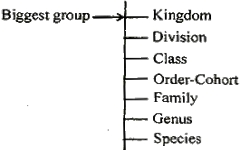Classification is not a single step process but involves a hierarchy of steps in which each step represents a rank or category. Since the category is a part of the overall taxonomic arrangement, it is called the taxonomic category and all categories together constitute the taxonomic hierarchy.
Taxonomy is the practice of identifying dissimilar organisms, classifying them into categories, and identification them. The taxonomic category is the hierarchy to categorize the diverse types of individuals into the accurate or suitable category by the observable characteristics as there are 1.7-1.8 million species in the living world.

Taxonomic categories and hierarchy can be illustrated by an example. Insects represent a group of organisms sharing common features like three pairs of jointed legs. It means insects are recognizable concrete objects which can be classified, and thus were given a rank or category. Remember, groups, represent the category. Category further denotes rank. Each rank or taxon, in fact, represents a unit of classification. These taxonomic groups/ categories are distinct biological entities and not merely morphological aggregates.
Taxonomical studies of all known organisms have led to the development of common categories such as kingdom, phylum or division (for plants), class, order, family, genus and species. All organisms, including those in the plant and animal kingdoms, have species as the lowest category.
- Kingdom
This is the first category of the biological classification. The kingdom is the category of closely related organisms. There are 5 kingdoms in which the living organisms are classified, namely, Animalia, Plantae, Fungi, Protista, and Monera.
- Phylum
It is the second category of the biological classification which is a group of directly related organisms. There are 35 phyla in kingdom Animalia. For Example – Porifera, Chordata, Arthropoda, etc.
- Class
The class is the third category of the biological classification which comprises of one or more related order. Ex; Kingdom Animalia includes 108 classes including class Mammalia, reptilia, aves, etc.
- Order
The order is the fourth category of the biological classification which comprises of one or more related families. There are around 26 orders in class Mammalia such as primates, Carnivora, etc.
- Family
It is the fifth category of the biological classification. The family comprises a group of the related genus. Here, family means, the organism of a similar area which are showing correlated characters. For eg., the families in the order Carnivora include Canidae, Felidae, Ursidae, etc.
- Genus
It is the sixth category of the biological classification which comprises of many species that demonstrate a few similarities within their group but vary from other species having dissimilar groups. The species vary from each other due to the dissimilarity in the organization. For eg., lion and tiger are placed under the genus Panthera.
- Species
It is the last category of the biological classification. Species are much diversified in nature. There are about 8.7 million different species on earth. One species can be differentiated from the other by observing differences in its morphology plus chemical and physical properties. It refers to a group of organisms that are comparable in shape, structure, reproductive features. Species can be more divided into sub-species.












